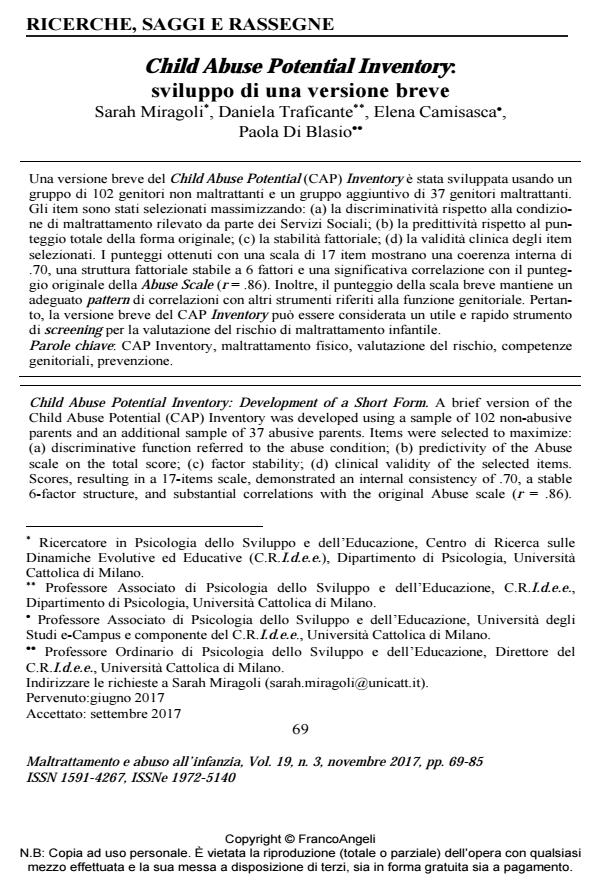Child Abuse Potential Inventory: Development of a Short Form
Journal title MALTRATTAMENTO E ABUSO ALL’INFANZIA
Author/s Sarah Miragoli, Daniela Traficante, Elena Camisasca, Paola Di Blasio
Publishing Year 2017 Issue 2017/3
Language Italian Pages 17 P. 69-85 File size 203 KB
DOI 10.3280/MAL2017-003005
DOI is like a bar code for intellectual property: to have more infomation
click here
Below, you can see the article first page
If you want to buy this article in PDF format, you can do it, following the instructions to buy download credits

FrancoAngeli is member of Publishers International Linking Association, Inc (PILA), a not-for-profit association which run the CrossRef service enabling links to and from online scholarly content.
Child Abuse Potential Inventory: Development of a Short Form. A brief version of the Child Abuse Potential (CAP) Inventory was developed using a sample of 102 non-abusive parents and an additional sample of 37 abusive parents. Items were selected to maximize: (a) discriminative function referred to the abuse condition; (b) predictivity of the Abuse scale on the total score; (c) factor stability; (d) clinical validity of the selected items. Scores, resulting in a 17-items scale, demonstrated an internal consistency of .70, a stable 6-factor structure, and substantial correlations with the original Abuse scale (r = .86). Moreover, the reduced scale’s score maintained appropriate correlations with other tools related to the parental function. Therefore, the brief version of the CAP Inventory may be useful as a time-efficient screener for abuse risk.
Keywords: CAP Inventory, child physical abuse, risk assessment, parental skills, prevention.
- Parents’ perception of child behavior, parenting stress, and child abuse potential: Individual and partner influences Sarah Miragoli, Stefania Balzarotti, Elena Camisasca, Paola Di Blasio, in Child Abuse & Neglect /2018 pp.146
DOI: 10.1016/j.chiabu.2018.07.034 - Postpartum depressive symptoms as a linking mechanism between maternal sleep and parenting stress: the conditional indirect effect by social support Elena Camisasca, Paola Di Blasio, Luca Milani, Sarah Miragoli, in Children's Health Care /2021 pp.64
DOI: 10.1080/02739615.2020.1824675 - Dallo stress economico al malessere psicologico dei minori durante la pandemia da Covid-19: quale ruolo per il conflitto co-genitoriale e le pratiche educative autoritarie? Elena Camisasca, Venusia Covelli, Sarah Miragoli, in MALTRATTAMENTO E ABUSO ALL'INFANZIA 1/2021 pp.13
DOI: 10.3280/MAL2021-001002
Sarah Miragoli, Daniela Traficante, Elena Camisasca, Paola Di Blasio, Child Abuse Potential Inventory: sviluppo di una versione breve in "MALTRATTAMENTO E ABUSO ALL’INFANZIA" 3/2017, pp 69-85, DOI: 10.3280/MAL2017-003005